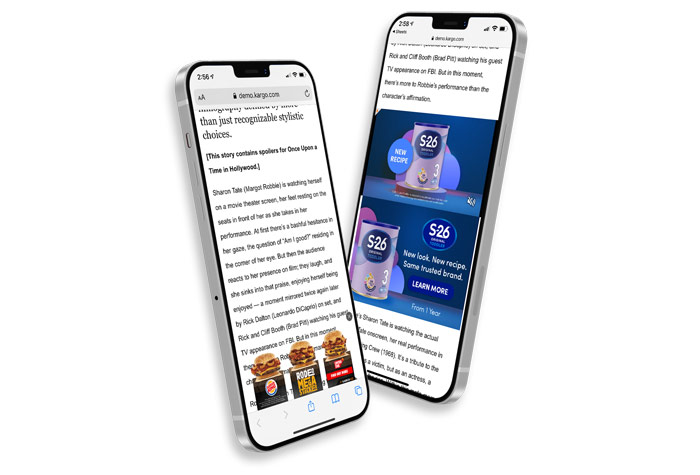
By Kargo APAC GM Rob Leach*
SYDNEY, Today: Media buying is both an art and science. In today’s targeting-obsessed programmatic advertising environment, I’d wager that most media buyers would prioritise by price, audience, placement and creative in that order.
However, this prioritisation of advertising campaign elements is entirely upside-down, with creative at the bottom when it should be right at the top. Don’t believe it? A study from IPSOS found that creativity accounts for 75% of a campaign’s performance. That’s a full three times more than the other elements combined.
Ticking Through The Priority List
The prioritisation of price put digital advertising on the brink of disaster in years past, with price driving ever lower, and quality going down with it. Once that was cleaned up with supply chain optimisation, the industry became obsessed with audience targeting, which also led to some less-than-savoury media placements and somewhat unrealistic scale (remember, an audience size should be about the same online as it is in real life!)
Now that we are seeing the demise of 3rd party cookies, we know that current audience targeting techniques will be irreparably damaged. Millions of people use cookie-blocking tools, they are regulated heavily in much of the world, and Apple already blocks them even if Google has just bought itself two more years. This threat is bearing down on the “audience first” approach that we’ve gotten used to in recent years. Brands are madly trying to find alternatives, but the reality is that a first-party-data approach will not be truly scalable.
So what’s next? With aligning brand messaging to editorial context proven to increase favorability by 107%, memorability by 76% and receptivity by 57%, many brands are starting to think about contextual targeting, focusing on placement as a potential augmentation to “cookie loss.” And that’s great. There are plenty of opportunities to test contextual targeting.
Funny that creative has got such short shrift in this conversation when it is such a large part of a campaign’s success.
Think About Creative In A New Light
When a media buying team is under pressure to perform, it’s natural that they focus on the elements that are most measurable. Traditionally that’s what got us to focus on price and audience, both easily scrutinised and attributable.
Now, creative is more measurable. Companies like VidMob and Celtra offer analytics that can unlock insights about hundreds of different creative elements. Platforms like Google, Amazon and Facebook offer insights on creative performance, too.
Creative is also able to be much more impactful than before. Advances from companies like SeenThis and Kargo offer specially designed creative to maximise engagement and provide more beautiful, performant experiences for viewers. Compared to standard banners, Kargo’s mobile-optimised creatives are seen by 70% more people and viewed 2x longer.
Yet, creative is often the last place brands focus as they look for new ways to improve their campaigns.

Start Collaborating
One issue is that creative is often part of a different loop than media buying. Creative teams operate separately from media teams and have different stakeholders that they answer to within the brand team. Often, the media team is handed creative that was already made and approved, with little room for changes. This often means that TV creative is repurposed for digital video and banners are not personalised for an audience or customised for a particular screen or placement.
These missed opportunities should be surfaced to stakeholders in order to change the cycle. Media and creative working together is what enables a feedback loop that will drive creative performance.
IAB Australia published an important white paper about the many opportunities creative offers, from personalisation to dynamic creative and purpose-built video for digital. This paper, which is from a few years ago, could easily be augmented now to include new research from Forrester about Intelligent Creativity, the growing practice of thinking about creative as yet another performance element from the very beginning of a campaign’s inception.
For example, mobile advertising makes up 85% of programmatic campaigns, yet receives very little special attention when it comes to creative design. Few brands design ads that include features that take advantage of the small, yet highly interactive screen.
Now’s The Time To Get Creative
Today, all signs point to creative. A creative-focused strategy is proven to drive brand awareness, favorability and recall, and there are more options than ever before to also gather creative insights in order to also influence metrics like click and conversions, too.
The hard part is more process-driven than technical, as teams need to communicate in new ways and get used to new metrics. That’s entirely solvable if people are motivated. And they should be, as the other elements are not nearly as influential on the overall outcome. It’s easy to just wring our hands over the impending loss of cookies and the rise of privacy laws limiting data capture. But it’s smarter to look at a solution that’s been in front of us all along: Focusing on creative. We know as consumers ourselves, a great creative execution stops us in our tracks, pulls us in and prompts an action. And we have ways of actually measuring that impact. So brands that use this time to structure their processes around creativity are likely to add to their successes.
*Robert Leach launched the Kargo business in the APAC region five years ago, having previously spent many years working in digital media around the world for some of the industry’s largest media organisations including Sky TV, News Corp and the BBC.
About Kargo
Kargo is a mobile-first advertising company that creates consistently innovative campaigns for over 200 of the world’s best-known brands. Our marketplace is an invitation-only collection of performant publishers that allows us to reach 100% of smartphone users globally, a scale that eclipses Google and Facebook while ensuring brand safety, exceptional viewability and maximum security against ad fraud. Additionally, Kargo is the first and only mobile advertiser to achieve 100% ads.txt compliance. Kargo is TAG certified and a member of the Coalition for Better Ads.
Share this Post
The post Brands, It’s time to embrace The Creative Renaissance appeared first on M+AD!.
More Stories
How NBC News’ Election Night Digital Wins Forecast the Future of Broadcast News
Around the World: AI & Christmas, a Temu crackdown and Aussie influencers
Here’s a Short Roundup for This Week